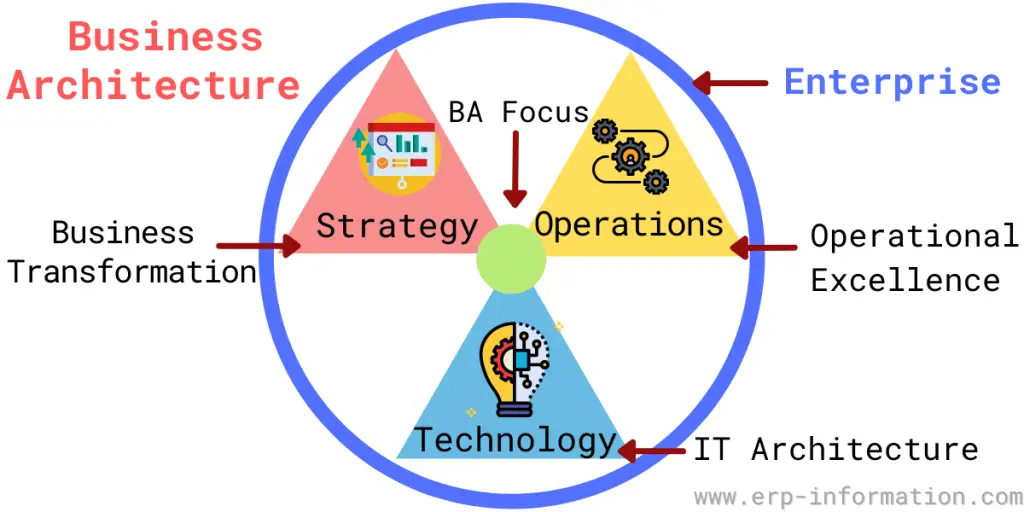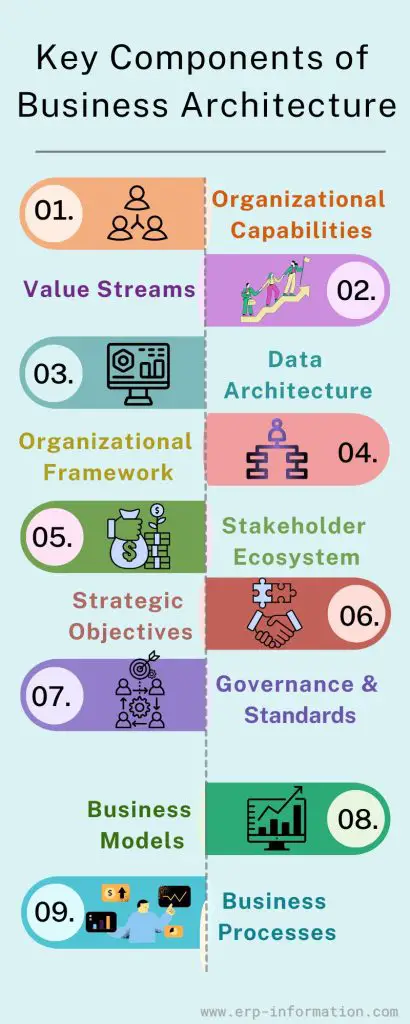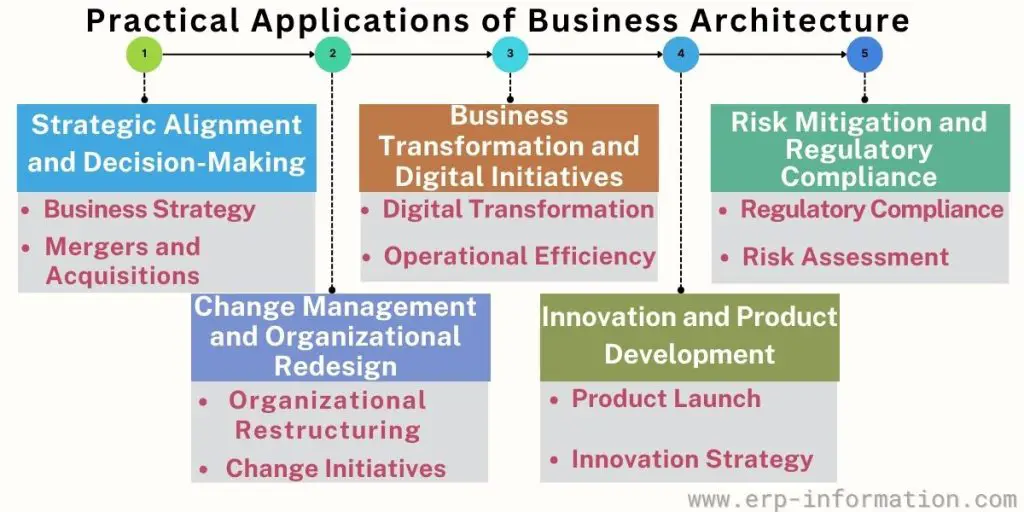Business Architecture is a vital component of corporate strategy. It provides a comprehensive blueprint that captures the holistic structure of an organization.
It encompasses business processes, information flows, and technological infrastructure, ensuring all elements work seamlessly together. By leveraging Business Architecture, companies can align their operations with strategic goals, optimize performance, and drive innovation.
This blog post discusses the definition, key components, frameworks, and methodologies of business architecture: It also provides tips for choosing the right framework.
What is Business Architecture?

Business Architecture is a strategic discipline that meticulously represents and designs the comprehensive structure of an organization.
It involves mapping out business processes, information flows, and technological infrastructure to ensure seamless alignment with the organization’s goals and objectives.
Serving as a strategic framework, Business Architecture bridges the gap between an organization’s vision and its operational realities.
By analyzing and designing business processes, functions, and structures, Business Architecture identifies areas for improvement, establishes clear rules and guidelines, and aligns every function with the overall strategy.
It provides a detailed blueprint for how a business operates, ensuring that every component of the organization works together harmoniously to achieve strategic goals. Business architecture not only enhances operational efficiency but also drives innovation and supports sustainable growth.
Key Components of Business Architecture
Business Architecture provides a holistic framework that captures the essence of an organization, allowing IT architects and business leaders to understand how a business operates and creates value.
Here are the primary elements:
1. Organizational Capabilities
Organizational capabilities represent the fundamental functions and skills that a business can inherently perform. These capabilities are high-level constructs that remain stable over time and are not dependent on the organizational structure.
Examples include “Market Analysis,” “Product Development,” and “Customer Support Services.”
Understanding these capabilities is essential for recognizing gaps, improving operations, and aligning resources with strategic goals.
2. Value Streams
Value streams show the series of steps to get a product or service to a customer. They depict how value moves through the business’s capabilities, offering a clear view of the end-to-end business processes.
This visualization aids in spotting bottlenecks and opportunities for enhancement, ensuring that each step in the process contributes value to the final product or service.
3. Data Architecture
Data architecture captures the key data entities or objects for the business. It establishes rules for organizing and using data, ensuring smooth information flow and effective usage.
By defining how data is managed and utilized, data architecture supports decision-making and operational efficiency.
4. Organizational Framework
This element delves into the formal hierarchy of the organization, detailing departments, teams, roles, and responsibilities.
It ensures that the organizational setup supports strategic objectives and that there is clear alignment across all units. A well-defined organizational framework enables effective communication, collaboration, and accountability.
5. Stakeholder Ecosystem
Identifying key stakeholders, both inside and outside the organization, is important for successful business architecture.
This process outlines the connections between various stakeholders, understanding their needs, influence, and effects on the business. By managing these relationships, organizations can improve engagement and align better with their strategic objectives.
6. Strategic Objectives
This section captures the organization’s goals and links them with other parts of the business architecture. It ensures the business is equipped to achieve its long-term vision and mission.
By aligning capabilities, processes, and structures with strategic objectives, businesses can maintain focus on their goals and drive continuous improvement.
7. Governance and Standards
Governance and standards establish the rules and guidelines that oversee different aspects of the organization. They ensure consistency, compliance, and alignment with best practices and regulatory requirements.
Clear governance and standards help maintain order and provide a framework for efficient business operations.
8. Business Models
Business models describe how an organization generates, delivers, and captures value. They outline revenue streams, target customer segments, key activities, resources, and partnerships necessary to sustain the business.
A well-defined business model helps organizations spot opportunities, adapt to market changes, and foster innovation.
9. Business Processes
Business processes represent the sequence of activities or tasks performed to achieve specific outcomes. They are critical for understanding how work is done within the organization.
By mapping out and optimizing processes, businesses can improve efficiency, reduce waste, and ensure that activities align with strategic goals.
Practical Applications/Use Cases
Business Architecture, with its comprehensive approach to understanding and structuring an organization, is valuable in many scenarios.
Here are some key use cases, explained in simple terms with practical examples:
1. Strategic Alignment and Decision-Making
- Business Strategy: Business Architecture helps leaders see what the organization excels at and identify weaknesses.
- For example, a retail company might discover through BA that it has a strong online sales process but needs improvement in its in-store customer service.
- Mergers and Acquisitions: When companies merge or acquire other businesses, Business Architecture plays an important role in ensuring that their processes and operations align seamlessly.
- For example, if a tech company acquires a startup, Business Architecture can assist in integrating the startup’s innovative practices with the parent company’s established procedures.
2. Business Transformation and Digital Initiatives
- Digital Transformation: It guides businesses in aligning new digital projects with their goals.
- For example, a traditional bookstore moving to an online platform can use Business Architecture to ensure its new digital storefront aligns with its customer service goals and inventory management systems.
- Operational Efficiency: By mapping out workflows, organizations can spot inefficiencies and improve them.
- For example, a manufacturing company might use Business Architecture to identify and eliminate redundant steps in its production process, speeding up output and reducing costs.
3. Change Management and Organizational Redesign
- Organizational Restructuring: When companies undergo major changes, Business Architecture ensures these changes support the overall strategy.
- For example, if a company decides to create a new department, Business Architecture helps ensure this new team fits well with the existing structure and goals.
- Change Initiatives: It provides a framework for managing big changes, like launching a new product.
- For example, if a beverage company introduces a new drink, Business Architecture helps align production, marketing, and sales efforts to support the launch.
4. Risk Mitigation and Regulatory Compliance
- Regulatory Compliance: Business Architecture aids organizations in understanding and adhering to industry regulations and laws.
- For example, a financial institution can map out its processes to ensure all activities comply with banking regulations.
- Risk Assessment: It helps find potential risks and create plans to reduce them.
- For example, an airline might use Business Architecture to pinpoint and address risks in its safety procedures, ensuring passenger safety and regulatory compliance.
5. Innovation and Product Development
- Product Launch: It ensures the organization is ready to support the launch of a new product or service.
- For example, a tech company launching a new app can use Business Architecture to ensure its IT infrastructure can handle the increased traffic.
- Innovation Strategy: For organizations aiming to innovate, BA provides insights into areas of strength and opportunity.
- For example, a pharmaceutical company looking to innovate might use Business Architecture to identify which areas of its research and development are most promising.
Frameworks and Methodologies
Effective Business Architecture relies on robust frameworks and methodologies. These frameworks provide structured approaches to design, analyze, and implement business architecture within an organization, ensuring that strategies, processes, and structures are seamlessly aligned.
TOGAF (The Open Group Architecture Framework)
TOGAF is a widely adopted framework that offers a comprehensive approach to enterprise architecture. It provides detailed guidance on designing, planning, implementing, and managing an organization’s architecture.
What sets TOGAF apart is its holistic perspective, encompassing business, data, application, and technology architectures.
Key Features
- Extensive tools and techniques for enterprise architects.
- Emphasis on aligning IT strategy with business goals.
- Structured methodology is known as the Architecture Development Method (ADM).
Advantages
- Supports a thorough and structured approach, facilitating alignment across different organizational units.
- Ideal for large enterprises due to its detailed and methodical nature.
Ideal For
Large organizations are seeking a detailed framework to guide their enterprise architecture initiatives.
Learn more about TOGAF
Zachman Framework
The Zachman Framework provides a foundational approach to business architecture, offering a structured way to view and define an enterprise. This schema organizes and classifies an organization’s architecture, ensuring a comprehensive understanding of business processes and structures.
Key Features
- Logical structure for organizing and classifying architectural artifacts.
- Focus on capturing the complexity of business operations through various perspectives.
Advantages
- Encourages a disciplined and systematic approach to documenting business architecture.
- Helps organizations understand and articulate the intricacies of their business processes.
Ideal For
Organizations need a robust foundational framework to thoroughly document and understand their business architecture.
Learn more about the Zachman Framework
How to Choose the Right Framework?
Choosing the right framework is crucial for successfully implementing business architecture. Here are some key points to consider:
Organization’s Needs and Goals
Understand the specific needs, objectives, and strategic goals of your organization. Different frameworks focus on various aspects of business architecture, so it’s important to align your choice with the organization’s priorities.
The Complexity of the Business
Consider the complexity of your business operations. Larger and more intricate organizations might benefit from a more detailed and structured framework like TOGAF, which provides extensive guidance and methodologies.
Availability of Resources and Expertise
Evaluate the availability of resources and expertise within your organization. Some frameworks, such as TOGAF, may require intensive training and expertise, so ensure your team has the necessary skills or can acquire them.
Integration with Existing Processes
Consider how the chosen framework will integrate with your existing processes and systems. The framework should complement and enhance your current workflows, not disrupt them. Ensure it aligns well with your organization’s existing methodologies and tools.
Traditional vs Modern Business Architecture Tools
Understanding the evolution of BA tools helps us appreciate how far we’ve come and the benefits modern tools offer. Here’s a breakdown of traditional versus modern business architecture tools:
Traditional Tools
Physical Models and Diagrams
- Description: In the past, business architects relied heavily on physical drawings and models. Whiteboards, paper diagrams, and physical models were used to plan and visualize complex business structures.
- Limitations: These tools were static, hard to share, and challenging to update. Collaboration was limited to those physically present.
Basic Documentation Tools
- Description: Spreadsheets and word processors were the primary tools for recording business architecture. These documents helped in manual documentation and tracking of processes.
- Limitations: They were not designed for dynamic or collaborative work, making it difficult to keep information current and share updates seamlessly.
Modern Tools
Collaborative Platforms
- Description: Modern business architecture utilizes platforms designed for real-time collaboration. Tools like Microsoft Teams, Slack, and specialized business architecture software allow multiple users to work on the same documents simultaneously.
- Benefits: These platforms enhance communication, ensure everyone has access to the latest information, and support teamwork across different locations.
Cloud-Based Solutions
- Description: With the advent of cloud technology, business architecture tools are now accessible online. Tools like AWS, Google Cloud, and SaaS applications allow businesses to operate seamlessly across different geographies.
- Benefits: Cloud-based solutions offer scalability, flexibility, and easy access to information from anywhere. They also provide enhanced security and automatic updates, ensuring the tools are always up-to-date.
Categories of Business Architecture Tools
Business architects use a variety of tools to design, document, and manage business architectures effectively. Here’s a breakdown of different types of tools, explained in simple terms:
| Enterprise Architecture Tools | Diagramming Tools | Project Management Tools | |
| Description | These are all-in-one solutions designed to help with the overall design and modeling of business architectures. | These specialized tools help in making diagrams, flowcharts, and other visual representations of business processes and structures. | These tools are designed to manage and oversee projects from start to finish. |
| Features | They include diagram creation, detailed reporting, and collaboration capabilities. | User-friendly interfaces and collaboration features make it easy for teams to work together. | They include options for tracking progress, managing tasks, and enabling team collaboration. |
| Benefits | These tools provide a comprehensive platform for business architects to create, share, and manage their designs in one place. | They help simplify complex information, making it easier to understand and communicate. | They help teams stay organized and ensure alignment with the project’s goals. |
Business Architecture Certification Courses
Earning certifications in business architecture can significantly enhance your skills and career prospects. Here’s a brief overview of the types of certification courses available:
Foundation Courses
Foundation Courses provide basic knowledge of business architecture concepts, principles, and practices. They are ideal for beginners or professionals new to the field, helping to build a strong foundation and understanding of essential business architecture elements.
Advanced Certifications
Advanced Certifications offer specialized training in specific areas of business architecture. These are suitable for professionals with some experience looking to deepen their expertise. By enhancing specialized skills, these courses prepare individuals for higher-level roles within their organizations.
Workshops and Seminars
Workshops and Seminars are short-term, interactive sessions focused on current trends and practical applications. They are great for continuous learners and networkers, providing up-to-date knowledge and opportunities to connect with industry peers.
Practical Experience
Practical Experience involves hands-on projects and real-world applications of business architecture principles. It is essential for professionals at all levels and is often required for advanced certifications.
Gaining practical experience ensures a thorough understanding and effective application of the skills learned in courses.
By choosing the right certification courses, you can build a successful career in business architecture, equipped with the latest knowledge and skills.
Comparison of Different Architectures
Here’s a comparison of various architectures, presented in a simple table format for easy understanding:
| Aspect | Business Architecture | Enterprise Architecture | Solution Architecture | IT Architecture | Business Analysis |
| Focus | Aligning business strategy with operational reality | Comprehensive view including business, IT, and technology architecture | Designing specific solutions to business problems | Technological infrastructure and systems | Identifying business needs and technical solutions |
| Scope | Business processes, capabilities, and strategy | The strategic context for solutions | Specific business problems and their technological solutions | IT systems and technology support | Detailed analysis of business needs and solutions |
| Context | Broad organizational context | Holistic organizational view | Specific project or problem context | Technology-centric view supporting business | Strategic context for solutions |
| Approach | Visualizing relationships between business entities and processes | Aligning all architectural aspects with business goals | Integration of technology to solve business issues | Ensuring a secure and efficient IT environment | Ensuring solutions align with broader business objectives |
| Interrelation | Provides the framework for business processes and strategies | Encompasses business architecture within a broader scope | Operates within the context set by business architecture | Supports the business goals defined by business architecture | Relies on business architecture for strategic alignment |
This table provides a clear comparison of how business architecture differs from and relates to other types of architecture and business analysis.
It helps in understanding the unique focus and scope of each discipline, ensuring a comprehensive grasp of their roles within an organization.
FAQs
What is a Business Architecture Guide?
The Business Architecture Guide, established by the Business Architecture Guild in 2010, promotes best practices and expands knowledge in the field. It helps in analyzing and designing business processes, functions, and structures, ensuring alignment with overall strategy. Essentially, it provides a blueprint for how a business operates.
What is the Business Architecture Association?
The Business Architecture Association started at DePaul to explore Business Architecture ideas and later formalized into a chapter-based organization.
What did the Business Architecture Association contribute to certifications?
They created the first practitioner exam, which became the beta version of the Business Architecture Guild’s certification program in 2014.
Conclusion
It is a critical part of any organization and should be designed to meet the specific needs of that company. Therefore, many considerations must be made when planning Business Architecture.
Still, it can help their organizations thrive in today’s competitive environment and prepare for future changes by taking all into account.
Thank you for reading! We hope you enjoyed the blog post!


